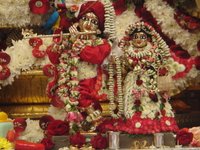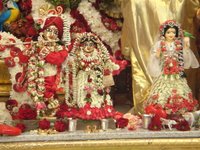Qualities of a Madhyama
īśvare tad adhīneṣu
bāliśeṣu dviṣatsu ca |
prema maitrī kṛpopekṣā
yaḥ karoti sa madhyamaḥ || Bhag 11.2.46 ||
"He, who has love for the Lord, who is a friend of His devotees, who is merciful to the ignorant and neglects the envious, is a madhyama-bhagavata."
So part from this being a definition of a 'madhyama' devotee, I think that the above conduct is approved by Bhagavan since the employment of such conduct defines one as such a madhyama, is it not? This is not to suggest that one should not aspire to be uttamas, but I am just trying to figure out whether the above verse rightly describes a devotee who is discriminating. Of course a devotee needs to emply discrimination in all or most circumstances whether they involve contact with people or not.
To my mind, it parallels with the pada of Sri Narottama das Thakura from PBC:
And since Sri Narottama is a siddha-guru, it is indeed amazing how he speaks as if he were a sadhaka. Such beloved gurus do great works for mankind by leaving behind indication sof signposts so that we may find the way. Doing this in a practical way simply has to be done in order to be experienced properly and how these ideas are fully transcendental. It cannot be understood on a theoretical level, which would be just like licking a jar of honey from the outside of the bottle as an infuential Gaudiya teacher once said.kāma krodha lobha moha, mada mātsarjya dambha saha,
sthāne sthāne niyukta koribo.
ānanda kori hṛdoy, ripu kori parājoy,
anāyāse govinda bhajibo. (21)
"I will engage lust, anger, greed, illusion, envy and pride all in their proper places. Thus I can defeat these enemies with a blissful heart and easily worship Govinda."kṛṣṇa sevā kāmārpaṇa, krodha bhakta-dveṣī jane,
lobha sādhu-saṅge hari-kathā.
moha iṣṭa lAbha vine, mada kṛṣṇa guṇa gāṇe,
niyukta koribo yathā tathā. (22)
"I offer my lust to the service of Krishna, my anger towards the enemies of His devotees and my greed towards association with saints and topics of Lord Hari. I am deluded without my beloved Lord, and I am proud when I sing Krishna's glories. Thus I engage all them in Krishna's service!"
I also checked out the definition of that Bhagavata verse in Sri Ananta das Babaji's 'Bhakta-tattva Vijnana' book, only to be slightly disappointed with the translation of madhyama as 'mediocre'. I humbly do not agree with the selection of this word, as current usage of 'mediocre' usually tends to refer to something that is rubbish and not worthy of consideration. This is inapplicable when considering the status of devotees; we all know that the madhyama is betwen the 'low' kanistha' and the 'high' uttama. I thought of using 'middling-devotee' to describe 'madhyama' but that is also olde english which would be hard to understand. 'Intermediate' seems to be a much better choice of word. Yes, the madhyama is certainly an intermediate devotee.







































